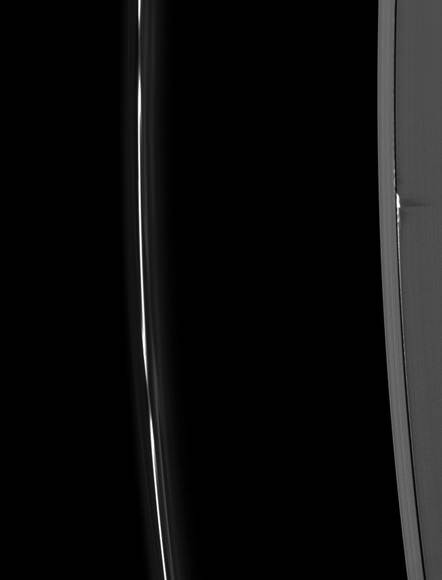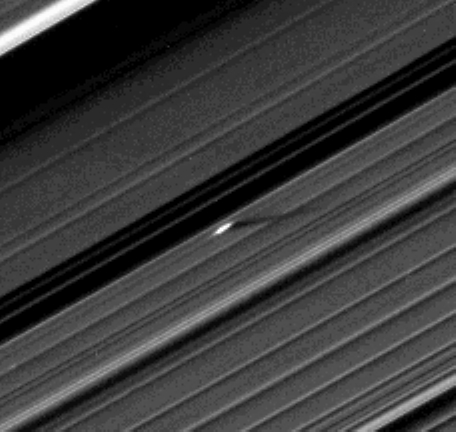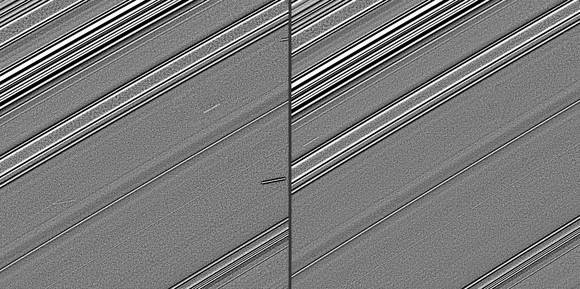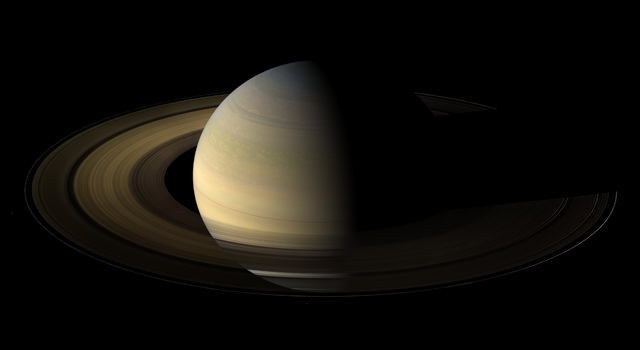[/caption]
Every 14.8 Earth years, equinox occurs at Saturn. But this is the first time there has been a spacecraft in situ to watch what happens when the sun is directly overhead at the equator, illuminating the rings directly edge-on. New images compiled from the Cassini spacecraft show a rare and breathtaking display of nature: the setting of the sun on Saturn’s rings. The image above — a mosaic of 75 different images — shows the beauty of this ringed world, but the most surprising revelation from these new images are that newly discovered lumps and bumps in the rings are as high as the Rocky Mountains.

The shadows in this image have lengths as long as 500 kilometers (310 miles), meaning the structures casting the shadows reach heights of almost 4 kilometers (2.5 miles) above the ringplane. These heights are much greater than those previously observed for the Daphnis edge waves, and are very likely caused by the distance between Daphnis and the inner edge of its gap getting unusually small at certain times
“We thought the plane of the rings was no taller than two stories of a modern-day building and instead we’ve come across walls more than 2 miles [3 kilometers] high,” said Carolyn Porco, Cassini imaging team leader at the Space Science Institute in Boulder, Colo. “Isn’t that the most outrageous thing you could imagine? It truly is like something out of science fiction.”
“The biggest surprise was to see so many places of vertical relief above and below the otherwise paper-thin rings,” said Linda Spilker, deputy project scientist at JPL. “To understand what we are seeing will take more time, but the images and data will help develop a more complete understanding of how old the rings might be and how they are evolving.”

An unusually large propeller feature has been detected just beyond the Encke Gap in this Cassini image of Saturn’s outer A ring, taken a couple days after the planet’s August 2009 equinox. Propeller-like features, a few kilometers long, centered on and created by the action of small embedded moonlets only about 330 feet (100 meters) across, were discovered early in the mission. These findings constituted the first recognition that bodies smaller than the 8-kilometer-wide ring moon, Daphnis, in the outer A ring and bigger than the largest ring particles (about 30 feet, or 10 meters, across) were present in Saturn’s rings.

Waves in the inner B ring, first seen in Saturn orbit insertion images, are now more obvious and distinct. This mosaic combines 15 separate images. Also visible are bright spokes, consisting of tiny particles elevated above the ring plane and surrounded by the dark outer B ring, can also be seen near the middle of the mosaic.

These two Cassini images, taken four years before Saturn’s August 2009 equinox, have taken on a new significance as data gathered at equinox indicate the streaks in these images are likely evidence of impacts into the planet’s rings.
In one unexpected equinox discovery, imaging scientists have uncovered evidence for present-day impacts onto the rings. Bright, and hence elevated, clouds of tiny particles, sheared out by orbital motion into streaks, up to 3,000 miles (5,000 kilometers) long, have been sighted in the A and C rings. These clouds — very likely thrown up by impacts — rising above the dark ring plane are more directly catching the sun’s rays during equinox, and are hence well lit and easily visible by contrast.
By the brightness and dimensions of the streaks, scientists estimate the impactor sizes at roughly one meter, and the time since impact at one to two days. These equinox data now lend more confidence to the impact interpretation of earlier Cassini images, taken in 2005, showing similar streaks in the C ring. In the 2005 images, the impactors are likely much smaller than one meter, and yet have left a visible ejecta cloud. All together, these observations are heralded as the first visual confirmation of a long-held belief that bits of interplanetary debris continually rain down on Saturn’s rings and contribute to their erosion and evolution.
Summing up the past several months of Cassini’s exploration of Saturn during this unusual celestial event, imaging team leader Carolyn Porco in Boulder, Colo., said, “This has been a moving spectacle to behold, and one that has left us with far greater insight into the workings of Saturn’s rings than any of us could have imagined. We always knew it would be good. Instead, it’s been extraordinary.”
For more images and information see CICLOPS.


Excellent article, Nancy!
Nice images. Saturn’s rings have such exquisite structure, and these tiny bumps are really fairly small perturbations.
LC
Well, having a structure the size of the rings which is “2 stories” tall – that’s outrageous.
Having perturbations in it that are “as tall as medium terrestrial mountains” – that’s less outrageous….
One would think of the almost negligible restoring force that develops as particle are pulled out of plane by the passing of a moon (especially if this happens in resonance, which I don’t know)
In high school, you calculate the (constant) force acting on a particle in an inverse-square field next to an infinite plate… and somehow this real-world example was never brought up…
I’ll go look for the numbers and figure it out now 🙂
Well, the best I found was that the rings weigh 3E19 kg, and are concentrates mostly between 75,000 and 137,000 km from the center of Saturn.
This gives a field of (G/2rho) = 4.6E-14 N / kg if I didn’t screw up
Is the bang-bang nature of the infinite plane field the reason why the rings are so flat? where’s an astrophysicist when you need one?
Dr. Flimmer?, Lawrence B. Crowell?, Torbjorn Laarson?
@Torbjorn Larsson, OM: Sorry about mispelling your name!
I would have to research the literature on Saturn’s rings. I agree that it is surprising that they have this extraordinary amount of structure, and they can be organized this way by a pretty weak gravity field. Many years ago I thought that maybe these particles were electrically chaged and moving in the magnetic field of the planet. If you work a Lorentz force equation plus gravity at about the same strength you get an interesting result. The particle ends up in a a vertically oscillating spiral or tubular orbit near one of the poles.
LC
The self-gravitation of the rings are negligible. What matters more is the gravitation of Saturn that point to Saturns center, and you have the centrifugal force that points always outward, but not (and this is important) radially away, but parallel to the rings. What you get when you add the forces (draw the vectors of the forces and the resulting vector), the net force will always point “into” the plane of the rings, because in that plain the gravitation and the centrifugal force really cancel.
This is the reason why the rings are flat (just like accretion disks).
Hopefully this explanation helps. If I didn’t do well, just say it and I will try to explain it again!
I could imagine a system of particles moving in nearly circular orbits around Saturn, but not with the same inclination or perihelion angle or argument. So there would be a cloud of particles orbiting Saturn. Even if these were in an approximate disk we need to ask by what mechanism the configuration of these particle orbits are tuned up into such a fabulously precise disk measuring only a few kilometers in width.
There are a number of possible mechanisms available. We might suppose mutual gravitation of these particles. However, that is pretty weak. Another would be collisions that statistically average velocities into a single disk. This might work if the collisions are not too strong, for other wise I might imagine this would scatter things more than regularize them. So this would act on average a bit like viscosity of a fluid. I think this is the argument usually given. To be honest I have found this to be a bit lacking , but I don’t know the details enough to make a strong argument.
Last week’s edition of the Universe on the History channel offered an interesting program on the ringed planets. It focused primarily on Saturn’s ring system, as it is obviously the most complex, but discussed the ring systems of Jupiter, Uranus and Neptune in less detail. The explanation given for the precise nature of Saturns rings was gravity as well as the apparent similar orbital velocity and proximity of the particles to one another. I’m sure this is a somewhat simplified view, but not being an astronomer or astrophysisist, this seemed to make as much sense as any other explanation. Thanks to Dr. Flimmer and Lawrence B. Crowell. Btw, your book looks interesting, I read the sample pages offered online, I may have to make the investment, but $45?? Is it possible to procure a used copy in these trying economic times?